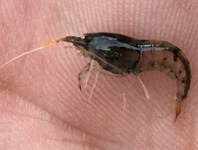Abstract
A new species of the Eigenmannia trilineata species group is described from the Loreto, Peru region of the western Amazon basin. The new species is similar in external appearance to members of the E. trilineata species group, but has a distinct phenotype, being diagnosed from congeners by the following unique combination of characters: four longitudinal dark pigment stipes on the lateral surfaces (over the lateral line, hypaxial muscles, proximal and distal pterygiophore margins); short, relatively round head (head depth 86.8–96.7% head length) with a terminal mouth; intermediate posterodorsal expansion of infraorbital bones 1+2 (60–75% length of infraorbitals 1+2); 11–15 teeth in three rows on the premaxilla; six to seven teeth in a single row on the endopterygoid; eye high on head (suborbital depth 28–36% head length); ii, 13–14 pectoral-fin rays; 183–219 anal-fin rays; and a uniformly dark brown head and pectoral fins on freshly-preserved specimens. The new species extends the geographic range of described species of the E. trilineata species group to the Western Amazon. This new species elevates the current number of valid species within the E. trilineata species group to 15, and the number of species within Eigenmannia to 20.
References
Albert, J.S. (2001) Species diversity and phylogenetic systematics of American knifefishes (Gymnotiformes, Teleostei). Miscellaneous Publications, Museum of Zoology, University of Michigan, Ann Arbor, 190, 1–127.
Albert, J.S. (2003) Family Sternopygidae. In: Reis, R.E., Kullander, S.O. & Ferraris, C.J. Jr. (Eds.), Check list of the freshwater fishes of South and Central America. Edipucrs, Porto Alegre, pp. 487–491.
Albert, J.S. & Crampton, W.G.R. (2005) Diversity & phylogeny of Neotropical electric fishes (Gymnotiformes). In: Bullock, T.H., Hopkins, C.D., Popper, A.N. & Fay, A.N. (Eds.), Electroreception. Springer Handbook of Auditory Research. Vol. 21. Springer-Verlag, Berlin, pp. 360–409.
https://doi.org/10.1007/0-387-28275-0_13Albert, J.S. & Fink, W.L. (1996) Sternopygus xingu, a new species of electric fish from Brazil (Teleostei: Gymnotoidei), with comments on the phylogenetic position of Sternopygus. Copeia, 1996, 85–102.
https://doi.org/10.2307/1446944Albert, J.S., Petry, P. & Reis, R.E. (2011) Major biogeographic and phylogenetic patterns. In: Albert, J.S. & Reis, R.E. (Eds.), Historical Biogeography of Neotropical Freshwater Fishes. University of California Press, Berkeley, pp. 21–58.
https://doi.org/10.1525/california/9780520268685.003.0002Albert, J.S., Carvalho, T.P., Chuctaya, J.A., Petry, P., Reis, R.E., Rengifo, B. & Ortega, H. (2012) Fishes of the Fitzcarrald, Peruvian Amazon. Lulu Press, Raleigh, 251 pp.
Campos-da-Paz, R. & Queiroz, I.R. (2017) A new species of Eigenmannia Jordan and Evermann (Gymnotiformes: Sternopygidae) from the upper Río Paraguai basin. Zootaxa, 4216 (1), 73–84.
https://doi.org/10.11646/zootaxa.4216.1.5Carvalho, T.P., Araujo Flores, J., Espino, J., Trevejo, G., Ortega, H., Jerep, C., Reis, R.E. & Albert, J.S. (2012) Fishes from the río Las Piedras, Madre de Dios basin, Peruvian Amazon. Checklist, 12, 973–1019.
https://doi.org/10.15560/8.5.973Carvalho, T.P., Tang, S.J., Fredieu, J.I., Corahua, I., Quispe, R., Ortega, H. & Albert, J.S. (2009) Fishes from the Alto Yuruá, Amazon Basin, Perú. Checklist, 5, 673–691.
https://doi.org/10.15560/5.3.673Correa, S.B., Crampton, W.G. & Albert, J.S. (2006) Three new species of the neotropical electric fish Rhabdolichops (Gymnotiformes: Sternopygidae) from the Central Amazon, with a new diagnosis of the genus. Copeia, 2006, 27–42.
https://doi.org/10.1643/0045-8511(2006)006[0027:TNSOTN]2.0.CO;2Dutra, G.M., de Santana, C.D., Vari, R.P. & Wosiacki, W.B. (2014) The South American electric glass knifefish genus Distocyclus (Gymnotiformes: Sternopygidae): redefinition and revision. Copeia, 2014, 345–354.
https://doi.org/10.1643/CI-13-066Hulen, K.G., Crampton, W.G. & Albert, J.S. (2005) Phylogenetic systematics and historical biogeography of the Neotropical electric fish Sternopygus (Teleostei: Gymnotiformes). Systematics and Biodiversity, 3, 407–432.
https://doi.org/10.1017/S1477200005001726Jordan, D.S. & Evermann, B.W. (1896) A descriptive catalogue of the species of fish-like vertebrates found in the waters of North America, north of the Isthmus of Panama. Bulletin of the United States National Museum, Washington, D.C., 1240 pp.
Lundberg, J.G. & Mago-Leccia, F. (1986) A review of Rhabdolichops (Gymnotiformes, Sternopygidae), a genus of South American freshwater fishes, with descriptions of four new species. Proceedings of the Academy of Natural Sciences of Philadelphia, 138, 53–85.
Ortega, H. & Vari, R.P. (1986) Annotated Checklist of the Freshwater Fishes of Peru. Smithsonian Contributions to Zoology, 437, 1–25.
https://doi.org/10.5479/si.00810282.437Ortega, H., Hidalgo, M., Trevejo, G., Correa, E., Cortijo, A.M., Meza, V. & Espino, J. (2012) Lista anotada de los peces de aguas continentales del Perú: Estado actual del conocimiento, distribución, usos y aspectos de conservación. Ministerio del Ambiente, Dirección General de Diversidad Biológica, Museo de Historia Natural, Lima, 56 pp.
Peixoto, L.A.W., Dutra, G.M. & Wosiacki, W.B. (2015) The electric glass knifefishes of the Eigenmannia trilineata species-group (Gymnotiformes: Sternopygidae): monophyly and description of seven new species. Zoological Journal of the Linnean Society, 175, 384–414.
https://doi.org/10.1111/zoj.12274Peixoto, L.A.W. & Wosiacki, W.B. (2016) Eigenmannia besouro, a new species of the Eigenmannia trilineata species-group (Gymnotiformes: Sternopygidae) from the São Francisco river basin, northeastern Brazil. Zootaxa, 4126 (2), 262–270.
https://doi.org/10.11646/zootaxa.4126.2.6Sabaj, M.H. (2016) Standard symbolic codes for institutional resource collections in herpetology and ichthyology: An Online Reference. Version 6.5. Available from: http://www.asih.org/resources/standard-symbolic-codes-institutional-resource-collections-herpetology-ichthyology (accessed 21 February 2018)
Tagliacollo, V.A., Bernt, M.J., Craig, J.M., Oliveira, C. & Albert, J.S. (2016a) Model-based total evidence phylogeny of Neotropical electric knifefishes (Teleostei, Gymnotiformes). Molecular Phylogenetics and Evolution, 95, 20–33.
https://doi.org/10.1016/j.ympev.2015.11.007Tagliacollo, V.A., Bernt, M.J., Craig, J.M., Oliveira, C. & Albert, J.S. (2016b). Data supporting phylogenetic reconstructions of the Neotropical clade Gymnotiformes. Data in Brief, 7, 23–59.
https://doi.org/10.1016/j.dib.2016.01.069Taylor W.R. & Van Dyke, G.C. (1985) Revised procedures for staining and clearing small fishes and other vertebrates for bone and cartilage study. Cybium, 9, 107–19.
Tello, M.S. & Cánepa, J.R.L.S. (1991) Estado actual de la explotación de los principals peces ornamentals de la Amazonia peruana. Folia Amazonica, 3, 107–128.
https://doi.org/10.24841/fa.v3i1-2.205Vari, R.P., De Santana, C.D. & Wosiacki, W.B. (2012) South American electric knifefishes of the genus Archolaemus (Ostariophysi, Gymnotiformes): undetected diversity in a clade of rheophiles. Zoological Journal of the Linnean Society, 165, 670–699.
https://doi.org/10.1111/j.1096-3642.2012.00827.xWaltz, B.T. & Albert, J.S. (2017) Family Sternopygidae. In: Van der Sleen, P. & Albert, J.S. (Eds.), Field Guide to The Fishes of the Amazon: Fish Genera of the Amazon, Orinoco, & Guianas. Princeton University Press, Princeton, pp. 341–345.

